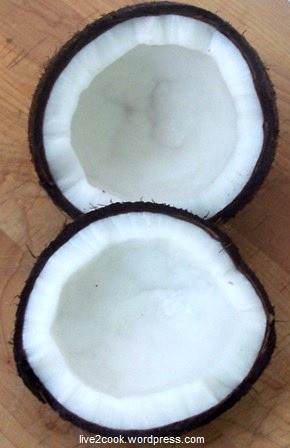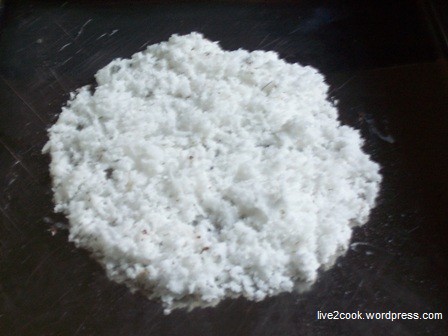Coconut Series I – The Artful Fruit June 23, 2008
Posted by live2cook in Coconut Series, General.Tags: All about Coconut
trackback
The Best thing about being born and brought up in Tropical country side is the exposure to the nature with exotic plants and trees. The first thing that comes to ones mind when we think about tropics is Coconut. We can’t imagine a sea shore without coconut or Palm trees. In India, coconut tree is denoted as “Karpaga Vruksham” which means “The miracle tree that brings all our dreams true”. There are couple of other trees that are denoted as “Karpaga Vruksham” too. If all the parts of a tree are useful in one or the other way to human, then the tree will get the name “Karpaga Vruksham”.
With Coconut tree, the leaves are used as roof, the trunk is used as beams of a hut, A drink is derived from its sap, the tender fruit has the refreshing coconut water, the mature fruit has the white flesh used in recipes, the outter husk of the fruit is used to make coir, the harder part after removing the husks for coir and the shells are used as a fuel medium in mud stoves. In our households, the outter husk is used in compost pits similar to peat moss. If we look at the Potpourri mixes that we get in craft stores here, we will find a “C” shaped stuff, which is nothing but the holding cap of the coconut. It is used as fixative in potporri. We can’t think a part of a coconut tree that goes into waste.
In Thanjavur, my birthplace, each and every house will have atleast two coconut trees. These will supply enough coconut for cooking, year round. We never bought coconut from stores. Whenever there are mature fruits in the tree, a handy man will help us to bring them down from the tall tree. Apart from this, the ripen fruit will fall down by itself. We used to collect them in big sack to store in the pantry. The fruits are dehusked as and when needed. Dehusking a coconut is an art by itself. We used to have a Crow bar (“Uri Paarai” in Tamil) for this. Since my dad is not a handy man, me and my younger sister learnt the art, out of necessity. If you get distracted while dehusking a coconut, you will end up hurting your hand badly on the Crow bar. There will always be a competition between me and my sister about who dehusked the most numbers. We will wait for my mom to return from work to declare the victory. Those were wonderful memories.
If dehusking is an art, storing the dehusked coconuts is another art. We learnt this from the store keeper who will buy coconuts from our house for resale. He taught us the trick and the purpose of the “Kudumi” (Tuft of husk) for the coconuts. In India they will leave a small part of husk over the eyes of the coconut. They wont dehusk completely as they do here in US. The purpose for leaving the husk is to denote how to store the coconut. Coconuts if stored with the three spots (eyes) facing the floor it will rot soon. The “Kudumi” on the top is the coconut language of saying “This side up”!!!
We learnt the trick of choosing the best coconut from him too. While buying a coconut the first thing to look is the amount of water it has. If we shake the coconut, we can hear the water. The more the water the better the sound. After picking the coconuts that has considerable amount of water, we have to press the Black spots (eyes) with our nails. If the eye part is too soft, then the coconut is rotten or about to rot in next few days. We haven’t failed in choosing the right coconut after learning the trick.
There is yet another trick involved with this “Miracle Fruit” – breaking the coconut. To break the coconut easily and into approximately two halfs, there is a secret. Wet the coconut in cold water before breaking. We use a tool similar to Sickle to break the coconut.
Last but not least, Scraping the coconut is an art too. Though we can shred or process coconut pieces in food processor there is a big difference in the texture and taste of a freshly scrapped coconut. Here is the cast Iron tool (Thuruva Manai in Tamil) that we use for scraping the coconut.
The tool has sharp edges that helps in scraping the coconut.
We hold the coconut in an angle against the sharp edges and move the coconut up and down the sharp edges which will provide even shreds of the white flesh. A tray similar to ancient winnowing baskets or winnowing trays are used to catch the coconut shreds in this process.
Here is the freshly scrapped coconut served…..
What can we do with freshly scrapped coconut? More on next posts in this series. I appreciate your memories and learnings related to coconut. Please share them through comments.










Love those tools, reminds me of my Mysore ajji! Great post, I love coconut!:))
Remember my hometown..lovely pics
yeah, that’s a nice post bringing back our memories.
hey even i use the samething but shape is diffeernt
great pics priya..btw i thought the coco grater was called aruvamanai!!!correct me if i am worng!!
Hi Asha,Vanamala,Uma,Sushma,
Thank you.
Hi Divya,
There are tow types of the same tool. One is used for cutting veggies which we call as “Aruvamanai”. The other one that is used for scraping the coconut is called “Thuruvamanai”. Thank you for sharing your thoughts.
Where can I get one of those things to grate coconut ? I have been trying with those flimsy rotating table top suction deals. Its useless.
Hi Live2cook, I was scouting around for a description of a coconut grater that we used at home. I’m linking my blog to yours for the description. I hope you don’t mind. If you have any issues, please let me know either on email or the blog.
[…] Live2cook has provided an awesome description of the same here […]
Reminds me of the days when I used to throw the coconuts at the Britishers and made them nuts.